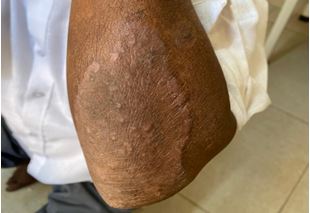An open label single arm prospective clinical study on the combined effectiveness of Panchanimbakam Churna Vati and Pathyadi Lepa in Kitibha Kushta (Psoriasis)
DOI:
https://doi.org/10.21760/jaims.7.7.5Keywords:
Kitibha Kushta, Psoriasis, Panchanimbakam Churna Vati, Pathyadi LepaAbstract
Kitibha Kushta is mentioned under Kshudra Kushta and is one among the Ashtamahagada. There is the involvement of Tridosha in all Kushta but the predominance of Dosha makes the types & manifestations of Kushta different. Psoriasis is one of the most common skin disorders. It is a papulosquamous disorder of the skin characterized by sharply defined erythematosquamous lesions. It is chronic and is well known for its course of remission and exacerbation. Prevalence of psoriasis in adults varies from 0.44 to 2.8%, with a much lower prevalence in children. The combined formulations Panchanimbakam Churna Vati and Pathyadi Lepa, mentioned in Gadanigraha and Yogaratnakara respectively, are indicated for the management of Kitibha Kushta. The combination collectively contains Kushtaghna Dravyas and has Katu, Tikta and Kashaya Rasa, Laghu, Ruksha Guna, and Ushna Veerya that are helpful in Samprapti Vighatana of Vata and Kapha dominant Kushta. Material and Methods: Among 30 registered participants, 25 completed the treatment. They were administered with Panchanimbakam Churna Vati orally 3 gm per day before food and Pathyadi Lepa externally for 30 days. The Lakshanas and PASI score was assessed on the 1st, 15th, and 30th. For Statistical analysis, subjective parameters were assessed by Cochran’s Q test followed by McNemar test, and objective parameters were assessed by Repeated Measures Anova and Paired T-Test. Results: There was a statistically significant improvement in the signs and symptoms of Kitibha Kushta (Psoriasis)(p<0.05). Conclusion: The combination of Panchanimbakam Churna Vati and Pathyadi Lepa, is effective in the management of Kitibha Kushta (Psoriasis)
Downloads
References
Sharma PV. Sushruta Samhita with Nibandhasangraha commentary of Dalhanacharya. Chaukambha Orientalia, Varanasi, 2002 (Reprint), Sutra Sthana33/5, p144
Rendon A, Schäkel K. Psoriasis Pathogenesis and Treatment. Int J Mol Sci. 2019;20(6):1475. Published 2019 Mar 23. doi:10.3390/ijms20061475
Dogra S, Mahajan R. Psoriasis: Epidemiology, clinical features, co-morbidities, and clinical scoring. Indian Dermatol Online J. 2016;7(6):471-480. doi:10.4103/2229-5178.193906
Sodhala. Pandeya, G Tripathi. Gadanigraha. Varanasi: Chaukambha Orientalia, Varanasi, 2002 (Reprint), Chikitsa Sthana33/5, p144
Suresh, B. S. (2005). Yogaratnakar: The "A" to "Z" classic on Ayurvedic formulations, practices & procedures, Sanskrit text with English translation and explanatory notes. Varanasi: Choukhamba Sanskrit Series Office.
Alzohairy MA. Therapeutics Role of Azadirachta indica (Neem) and Their Active Constituents in Diseases Prevention and Treatment. Evid Based Complement Alternat Med. 2016; 2016:7382506. doi:10.1155/2016/7382506
S. Ismail, M. Asad Immunomodulatory activity of Acacia catechu Indian J Physiol Pharmacol, 53 (1) (2009), pp. 25-33
An J, Li T, Dong Y, Li Z, Huo J. Terminalia Chebulanin Attenuates Psoriatic Skin Lesion via Regulation of Heme Oxygenase-1. Cell Physiol Biochem. 2016;39(2):531-43.
Heng MC, Song MK, Harker J, Heng MK. Drug-induced suppression of phosphorylase kinase activity correlates with resolution of psoriasis as assessed by clinical, histological and immunohistochemical parameters. Br J Dermatol. 2000 Nov;143(5):937-49. doi: 10.1046/j.1365-2133.2000.03767.x.
Ghosh A, Tiwari GJ. Role of nitric oxide-scavenging activity of Karanjin and Pongapin in the treatment of Psoriasis. 3 Biotech. 2018 Aug;8(8):338. doi: 10.1007/s13205-018-1337-5.














